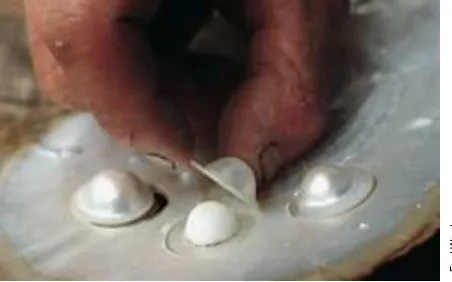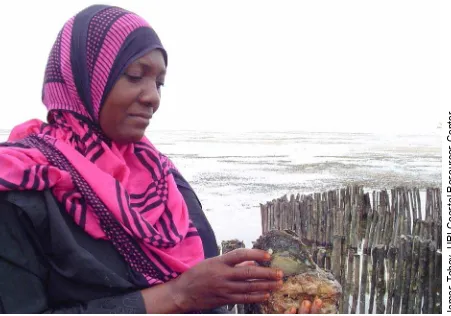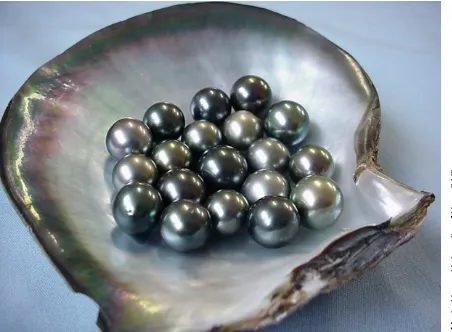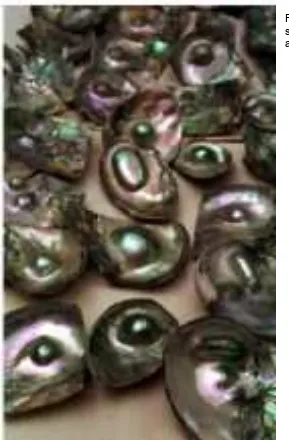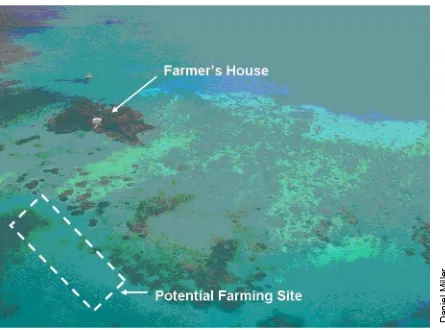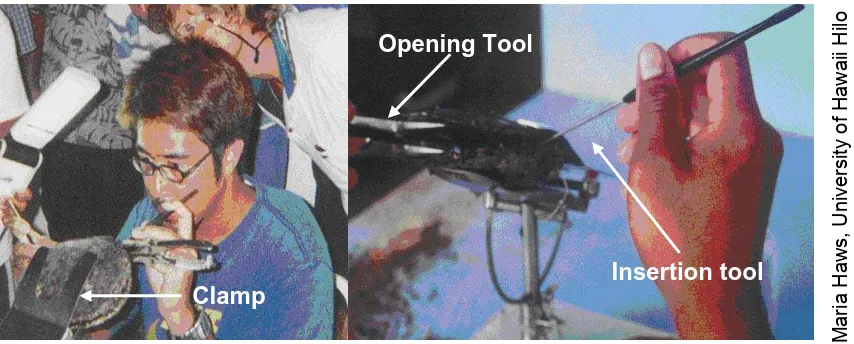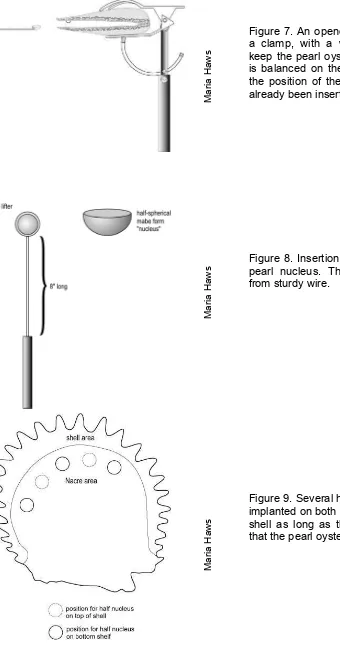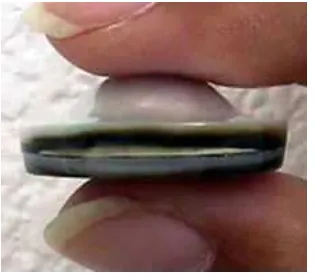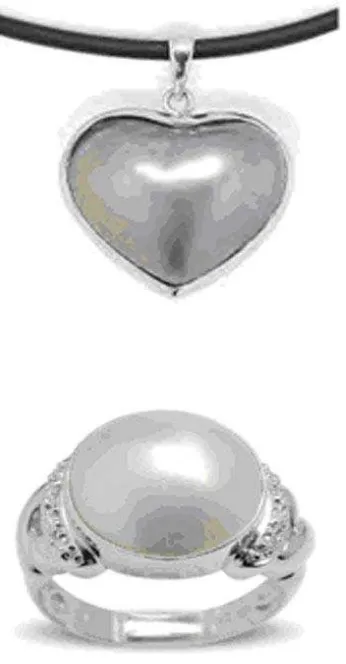Producing Half-Pearls
(Mabe)
2006
Producing Half-Pearls (Mabe)
2006
Haws, Maria C., Ellis, S.C. and Ellis, E.P.
The Sustainable Coastal Communities and Ecosystems Program (SUCCESS)
A Component of the Global Program for the Integrated Management of Coastal
and Freshwater Systems (IMCAFS)
Other contributing partners
This publication is available electronically on the Coastal Resources Center’s website at http://www.crc.uri.edu. For more information contact: Coastal Resources Center, University of Rhode Island, Narragansett Bay Campus, South Ferry Road, Narragansett, Rhode Island 02882, USA. Tel: (401) 874-6224; Fax: (401) 874-6920; Email: [email protected]
Also available electronically on the website of the Pacific Aquaculture and Coastal Resources Center, University of Hawaii Hilo at www.uhh.hawaii.edu/~pacrc. For more information, contact PACRC, University of Hawaii Hilo, Hilo, HI 96720, USA. Tel (808) 933-0707; Fax (808) 933-0704; Email: [email protected]
Citation: Haws, M.C., S.C. Ellis, and E.P. Ellis. 2006. Producing Half-Pearls (Mabe). Western Indian Ocean Marine Science Association, University of Dar es Salaam, University of Hawaii, Hilo and the Coastal Resources Center, University of Rhode Island. pp. 17.
Disclaimer: This manual is made possible by the generous support of the American people through the United States Agency for International Development (USAID). The contents are the responsibility of the Western Indian Ocean Marine Science Association, the Pacific Aquaculture and Coastal Resources Center at the University of Hawaii-Hilo and the Coastal Resources Center at the University Rhode Island as part of
the Sustainable Coastal Communities and Ecosystems
(SUCCESS) Program and do not necessarily reflect the views of the United States Government. Cooperative Agreement Number EPP-A-00-04-00014-00.
Cover Photo: Half pearls on black-lip pearl oyster shell from Nukuoro Island, Federated States of Micronesia.
Cover Photo Credit: Maria C. Haws
iii
Table of Contents
Acknowledgements ...ii
Preface... iii
Introduction ... 2
History of Pearls in East Africa... 3
What is a Pearl?... 3
Round pearls... 4
Half-pearls... 5
Benefits of pearl culture ... 6
Resources needed to produce half-pearls ... 6
Selecting a farm site... 7
Obtaining pearl oysters ... 8
Half-pearl (Mabe) implantation... 9
Implanting the nucleus ... 9
Culturing implanted pearl oysters... 13
Harvesting half-pearls ... 13
Processing the half-pearl to create a mabe... 14
Jewelry making with Mabe... 16
Acknowledgements
The authors wish to thank the pearl farmers of Micronesia and the Cook Islands for having contributed to the knowledge that has made this manual possible. The following individuals are also recognized for their contributions during preparation of the manual: Brian Crawford, Lesley Squillante, Abelardo Rojas Umaña, Harry Rhea, Aviti,Mmochi Juma Kipanga, Godfrey Mokoki, David Mirera, Quentin Fong, Edwin Requintina, Dai Kawachi and the women shellfish farmers at Fumba, Zanzibar. Special thanks to Fred Ward, Simon Ellis, Daniel Miller, James Tobey, the American Pearl Company and Douglas McLaurin of Perlas del Mar de Cortez for graciously giving permission to use their photographs. The American Pearl Company is also gratefully acknowledged for an additional donation to the half-pearl project at Fumba.
Preface
In 2004, the Coastal Resources Center (CRC) of the University of Rhode Island was awarded by the United States Agency for International Development (USAID) a five-year “Leader with Associates Cooperative Agreement” to implement a program entitled “Sustainable Coastal Communities and Ecosystems (SUCCESS). This Program is implemented in collaboration with the University of Hawaii Hilo, Western Indian Ocean Marine Science Association (WIOMSA), EcoCostas, and Universidad Centro America. Other partners are: Conservation International, The Nature Conservancy, World Wildlife Fund and the Sea Grant Network. The overall objective of the SUCCESS Program is to assist coastal communities in selected countries in Eastern Africa and Latin America improve both their quality of life (health, income, education) and their physical environment through good governance.
Working toward this goal, in Eastern Africa the Program is initiating a number of mariculture activities for seaweed, tilapia, milkfish, shellfish and half-pearl. Since many of these are unfamiliar to most coastal communities, it is critically important to produce publications that providemstep-by-step details on how to undertake these activities. Currently, such publications are unavailable—particularly in Eastern Africa. Furthermore, implementation of these activities has generated interesting results, which are important to share widely within and outside the region.
This manual provides an overview of low-cost and environmental-friendly half-pearl production for coastal communities. The manual provides practical guidance on how to select suitable farm sites; obtain adequate pearl oysters; implant nucleus into the pearl oyster; process the half-pearl and make jewelry.
The manual is designed to help extension agents and other practitioners working with coastal communities to provide technical support required in initiating and maintaining half-pearl farming.
Comments and suggestions are most welcome. The authors, the SUCCESS Program, WIOMSA and the rest of the participating institutions believe this manual will be useful to Tanzania and the region at large.
2
Introduction
Pearl production is a thriving business for coastal communities in many parts of the world including French Polynesia, Philippines, Indonesia and Australia. While round pearls are the type of pearl people are most familiar with, the majority of pearls are not round and come in a variety of shapes, sizes and colors. One type of pearl is the "mabe" pearl (Figure 1). Mabe is the Japanese name for the end product of "blister" or "half-pearls", which form on the inside surface of a pearl oyster's shell (Figure 1). After the blister of half-pearl is fully formed, it is cut out, filled with resin and polished to become a mabe, which is then made into a variety of jewelry such as rings, pendants or brooches (Figure 12).
Half-pearl production is particularly well suited to coastal communities or individuals who wish to farm pearls, but who lack the funds or skills to immediately start producing round pearls. Half-pearl farming is much simpler and less costly to get started. Although some training is involved, almost anyone can learn the methods to produce half-pearls. In contrast, producing round pearls requires hiring a specially trained technician. It also requires being able to pay this person to work for you. While half-pearls do not sell for as much as a high quality round pearl, they are in demand for jewelry making and can be sold at a good price. For example, a small (10 mm) mabe rated as "good" in quality could be sold to a jewelry for around $50, while a 15 mm mabe of the same quality could sell for $85-$95 (Gemworld International, Inc., 2006). The actual price the farmer receives depends on whether he or she sells directly to the jeweler or a middleman. More than one half-pearl can be made from a single pearl oyster so the harvest of several half-pearls from one pearl oyster may equal the revenues from a single round pearl.
Figure 1. The nacre dome deposited by the pearl oyster is lifted off to reveal the shell nucleus that was glued inside the gold-lip pearl shell 6-12 months earlier.
F
re
d
W
a
History of Pearls in East Africa
The coast of East Africa and the nearby islands are legendary for their ancient pearl fisheries which produced shells for mother-of-pearl and natural pearls, supplying much of the Middle East and Europe for centuries (Kunz and Stevenson, 1904). The most common species of pearl oyster found along the East African coast is the Black-lip pearl oyster, Pinctada margaritifera. Unfortunately, pearl fishing all over the world declined drastically once air-supplied diving gears were introduced leading to overfishing. Pearl oysters continue to be abundant on many parts of the East African coast, but pearling is no longer a major industry. Most recently, efforts to revive pearling through half-pearl farming have been undertaken at Mafia Island with good initial success (Rumaki, 2005). With good management of the pearl oyster resource and the interest of coastal communities, East Africa might once again become famous for its beautiful pearls.
What is a Pearl?
Mollusks are soft-bodied animals with one or two hard shells-for example, snails, clams and oysters. When a foreign object, such as a worm or a grain of sand, gets into the shell of a mollusk, its soft body is irritated. This irritation provokes the natural defensive response of the animal, which is to attempt to cover the foreign body with nacre, the smooth, lustrous shell material found on the inside of a mollusk's shell. Nacre is also called mother-of-pearl. Natural pearls formed in this fashion are usually irregular in shape.
Ja
Figure 2. A Zanzibar shellfish farmer holding a pearl oyster. This oyster is the smallest size that could be used to produce half-pearls.
Round pearls
Farmed pearls come from a variety of pearl oyster species. A pearl farmer attempts to imitate the natural process of pearl formation by inserting a foreign body, in this case a "nucleus", into the mollusk and hoping it will become covered with nacre (Figure 3), thereby becoming a valuable pearl. Round beads made from freshwater mussel shell serve as the nucleus for round pearl production. The nucleus is inserted into the gonad (sexual organ) of the pearl oyster along with a piece of the mantle tissue that produces nacre. Once transplanted into the gonad, the piece of mantle tissue deposits nacre around the nucleus to form a round (or nearly round) pearl in 12-18 months (Figure 3).
Figure 3. Round pearls resting on a polished pearl shell.
The shiny, interior lining of the shell is called “nacre” and is what covers a pearl.
Figure 4. An assortment of differently shaped mabes, the processed end of a half-pearl.
F
re
d
W
a
rd
Half-pearls
Half-pearl farming more closely imitates the natural process of pearl formation. The nucleus used is made from plastic. These plastic forms come in a variety of shapes such as round, oval, heart-shaped or stars (Figure 4). The pearl oyster is opened and several plastic nuclei are glued onto the inside of the top and bottom shell. In 9 to 12 months, enough nacre will have been deposited in a thick coat over the nuclei to create a dome (Figure 1). The half-pearl can then be cut out of the shell, processed and made into jewelry.
Benefits of pearl culture
Half-pearl farming is a relatively simple form of aquaculture because pearl oysters do not require artificial feeds, complicated farm structures or constant attention. If properly managed, pearl farming will not harm the environment and can increase the wild pearl oyster population over a period of years. For these reasons, pearl culture may be one of the best opportunities for business development in many isolated island areas.
Half-pearl farming is an attractive business venture because of the high value of the final product and the relative ease of producing half-pearls. Although some training is needed to learn how to implant the pearl nucleus, care for the pearl oysters and process the half-pearls after harvest, these simple skills can be learned by most people very quickly.
Although half-pearls vary greatly in value depending on the size and quality, large, high quality mabe sell for $5-25 USD each (farm gate price). A single pearl oyster can produce between four and six half-pearls depending on the size of the pearl oyster and how the nuclei are placed. Once processed and set as jewelry, they can sell for much higher prices.
One of the principal advantages of half-pearl production is that the final product is lightweight and nonperishable and is therefore suitable for production in remote areas that may have trouble with other products such as fish, which require refrigeration or quick sales. It normally takes about nine months to produce a half-pearl so they can be sold fairly soon after implantation. Once half-pearls are being produced, they can provide the basis for local jewelry and handicraft manufacture to provide additional income.
Resources needed to produce half-pearls
Production of high quality half-pearls is only possible under certain conditions. Before starting a farm, determine whether you have the following:
• A suitable farm site;
• A reliable source of pearl oysters;
• Sufficient funds to establish and operate a farm;
• Access to the mabe nucleus, implantation tools and other supplies;
• Ability to learn the skills required;
• Willingness to work hard in the water; and
• Ability to market half-pearls.
If you cannot meet these requirements, you should not consider half-pearl culture as a business opportunity. The following pages provide details on what is involved in each step of half-pearl farming.
Selecting a farm site
Pearl oysters need to be farmed in a place that lends itself to healthy growth of the oyster. The half-pearl farmer needs a place where she can work easily and assure that the oysters are safe. A good farm site would have the following characteristics:
itself to healthy growth of the oyster. The half-pearl farmer needs a place where she can work easily and assure that the oysters are safe. A good farm site would have the following characteristics:
• Clean, ocean water with little cloudiness or freshwater influence;
• Clean, ocean water with little cloudiness or freshwater influence;
• Some current to bring in fresh seawater, but not so fast that it is difficult or dangerous to work;
• Some current to bring in fresh seawater, but not so fast that it is difficult or dangerous to work;
• Water temperatures should be relatively constant without drastic changes;
• Water temperatures should be relatively constant without drastic changes;
• Pearl oysters should be underwater (at least 2 meters depth) most of the time; areas that are exposed during low tides or where the water heats up during low tide are not suitable;
• Pearl oysters should be underwater (at least 2 meters depth) most of the time; areas that are exposed during low tides or where the water heats up during low tide are not suitable;
• The farmer must be able to guard and protect the pearl oysters from theft;
• The farmer must be able to guard and protect the pearl oysters from theft;
• Farming should not interfere with other economic activities or impede boating; and
• Farming should not interfere with other economic activities or impede boating; and
• The farm should be far from sources of water pollution of any type
• The farm should be far from sources of water pollution of any type
Generally, if pearl oysters are growing in the area where you would like to establish a farm, then the site will be a good one for half-pearl farming.
Generally, if pearl oysters are growing in the area where you would like to establish a farm, then the site will be a good one for half-pearl farming.
Figure 5. An example of a good pearl farming site in Fiji with clean water, within sight of the farmer’s house but far from major towns, and with water between 2 to 20 meters depth. Try to
position the farm so it is not on top of corals.
Obtaining pearl oysters
There are three ways to get enough pearl oysters to start a half-pearl farm.
1. Collect adult pearl oysters or young pearl oysters (called spat) from the reef. Adult pearl oysters should only be collected in the case of starting small, pilot farms to avoid depleting the wild population. It is important to maintain a large adult breeding population in the wild so that enough spat are produced for spat collection.
2. Spat collection. This process involves placing artificial materials in the water so that small pearl oyster larvae can set on the material, grow and then be removed for farming. For example, in Zanzibar it is common to see small pearl oysters attached to the wood stake corrals used to grow shellfish. Other methods are described in "Collecting Black-lip Pearl Oyster Spat" (Haws and Ellis, 2000), which is available at the Institute of Marine Sciences (IMS). This publication can also be viewed online at www.ctsa.org/publications. IMS also has information on how to collect spat in Tanzania (Dubi, 2004).
3. Contact a hatchery. These may not exist in many areas such as Tanzania as they are costly to operate.
The best option for the new half-pearl farmer is to first collect a few pearl oysters from the reef (or other place of settlement) to start a very small pilot farm before attempting to establish a larger farm. When removing pearl oysters from their place of attachment, be sure to remove the pearl oyster by cutting the byssus threads (the green threads that pearl oysters use to attach themselves to the reef) with a sharp knife). Never try to detach a pearl oyster by pulling it loose as this can kill the pearl oyster. Once you have had some success with pearl farming using a few oysters, you can then establish a larger farm using spat collection. Spat collection is a better way to obtain pearl oysters for a farm since this allows for a good supply of very young pearl oysters and this is a more environmentally sustainable approach.
It is best to use young pearl oysters as they produce the most beautiful pearls most rapidly. You can distinguish a young pearl oyster (less than 2-3 years old) from an older pearl oyster in several ways. First, younger pearl oysters are generally smaller than older ones. It takes about 18 months for a pearl oyster to reach an adult size of about 10 cm or so. Secondly, even when younger oysters reach the adult size (over 10 cm in length) they will generally have a brighter, less-worn appearance. They also usually will have shell edges that are growing rapidly—as indicated by the presence of spines or "fingers" at the edge of the shell. Pearl oysters which are older than 2-3 years generally have a shell surface with a worn, dull appearance, and have shell edges that are smooth. While older pearl oysters can be used to produce half-pearls, they may produce less lustrous pearls. One should try to use the smallest pearl oysters possible for producing pearls.
Once enough young adult pearl oysters are collected, work can begin. This starts with cleaning the oyster shells of any fouling materials. Clean frequently to prevent build-up of these materials. The easiest way to do this is by removing these gently with a sturdy knife or wire brush taking care not to leave them out of the water for more than 20 minutes or so. Keep the oysters on your farm site for at least two months before implanting the nuclei. This gives the oysters time to become accustomed to being held on the farm.
Half-pearl (Mabe) implantation
Farming half-pearls has six main steps:
1. Obtaining and growing enough pearl oysters to start farming;
2. Implanting the nucleus into the pearl oyster to start formation of the half-pearl;
3. Caring for the pearl oyster while it is producing a half-pearl;
4. Harvesting the half-pearl;
5. Processing the half-pearl; and
6. Selling the half-pearls.
Implanting the nucleus
The process of forming half-pearls begins with gluing a special plastic form (nucleus) on the interior of the pearl oyster shell. You can use polycyanoacrylate glue, also known as Super Glue™. Super Glue™ is available in ordinary shops as well as hardware shops in Tanzania. Once glued onto the shell, the presence of the nucleus will stimulate the pearl oyster to protect itself against the irritation by covering it with nacre, thus forming a half-pearl. In Figure 1, the nacre dome that was formed over the plastic nucleus can be clearly seen.
For half-pearl production, a pearl oyster that is 10 cm long is ideal. Note that a CD is 12 cm wide, so an easy method to determine if a pearl oyster is the right size is to compare it to a CD. If the pearl oyster is just slightly smaller than a CD, it should be large enough to work with. It should have "spines" or "fingers" at the shell edges, as this indicates good health and vigorous growth.
Half-pearl nuclei are made from hard plastic and are most commonly round, oval, heart- or teardrop-shaped. One side is flat and the other rounded. These range in size from 0.3 inches (8 mm) to 0.6 inches (15 mm) in diameter and cost $0.05-$0.10. The best size to use in implantation is the 0.3–0.4 inches (8-10 mm). Half-pearl nuclei made specifically for half-pearl production can be ordered (see appendix for a supplier of nucleus) and come in a variety of shapes. However, just about any small plastic object with one flat side can be used. For the beginning farmer or jewelry maker, the round or oval shapes are the easiest to work with when it comes time to remove the pearl from the shell.
Ma
Figure 6. Implanting nucleus in a pearl oyster
First, carefully open the pearl oyster so you can see inside and select a good spot
to glue the nucleus.
Open the pearl oysters by removing them from water and allowing the shell to open naturally which takes about 20 minutes. Holding the pearl oyster upright will speed up the opening. Then insert a wedge of wood (6) on the side of the shell to keep it open. If you do not want to wait for the oyster to open by itself, you can open the shell using the flat-edge opening tool and speculum. If you use the speculum, insert in on the same side of the oyster as the byssus threads as this puts less stress on the adductor muscle. Do not try to open the pearl oyster more than 0.3 inches or 8 mm or you risk injuring the pearl oyster. Place the pearl oyster in a clamp to hold it securely (Figures 6 and 7). The clamp and other accessories for pearl implantation are available at the Institute of Marine Science (IMS) in Zanzibar and can be purchased over the Internet from suppliers1. Also, all the needed tools can be made by a
farmer.
Look for areas on the inside of the shell where the nacre is lustrous and of the
desired color.
The half-pearl will have the same color as the area on the shell where it is glued. If it is placed near the colored area close to the edge of the shell, it will have a dark, iridescent quality. If placed further inside the shell, it will be white or silvery. The color of mabe you decide to grow depends on what your customers will buy; it is important to determine this before starting pearl farming. It helps to have a lamp or flashlight to be able to see inside the shell so you can place the nucleus in precisely the spot you desire. You can also use a small dental mirror to examine the inside of the shell for a spot with good nacre to glue the nucleus.
1
Attica Marine. P.O. Box 291, Hamilton Hill, 6163 Western Australia. Phone (08) 93311955 Fax (08) 93376582. Website: http://www.attica.iinet.net.au/
Figure 7. An opened pearl oyster held in a clamp, with a wedge being used to keep the pearl oyster open. The nucleus is balanced on the insertion tool. Notice the position of the half-pearl, which has already been inserted.
Figure 8. Insertion tool and a round half-pearl nucleus. The tool can be made from sturdy wire.
Figure 9. Several half-pearl nuclei can be implanted on both the top and the bottom shell as long as the positioning is such that the pearl oyster can still close.
Carefully select the spot inside the shell for attaching the nucleus
Using a cotton swab or small sponge, dry the part of the shell where you want to place the plastic nuclei. Pick up the nucleus on the lifter (Figures 8 and 9) with the flat side up. Put a drop of Super Glue™ on the flat side of the nucleus. Use only a small amount of glue to attach the nucleus to the selected spot. Press the nucleus firmly against the top shell and hold for 10 seconds. The nucleus should stick. You can put several nuclei on the shell, space them so that they are at least 3 cm apart. Then, turn the pearl oyster over and put it back in the clamp. Now you can put several more nuclei on the other shell. Be sure to position these so they are not directly in line with the nuclei on the other shell or the pearl oyster will not be able to close (Figure 9).
Take care not to leave the pearl oyster open for more than a few minutes. As soon as possible, put the pearl oyster back in the water on the farm site so it lies on its side. Remember that the pearl oyster has just undergone a form of surgery and needs to be returned to the water very quickly in order to avoid more stress, which could kill it. If it is absolutely necessary to hold the pearl oyster on land for a while before transporting it back to the farm, the best way to do this is to lay it on its side in a shady area and cover with clothes or leaves dampened with fresh sea water to keep the oyster moist. Do not keep pearl oysters in buckets or containers of water. That will cause the pearl oyster to open and begin breathing, which will deplete the water of its oxygen and cause the animal to suffocate.
Cautions
• Do not use nuclei that are so large that the pearl oyster cannot close its shell after the implantation
• You can implant up to five nuclei in a large pearl oyster (over 10 cm) or three in a medium-sized one (less than 10 cm).
• Nuclei can be attached to the upper and lower shells, but stagger their locations so that the pearl oyster can close its shell afterwards (Figure 9 shows how to place mabe nucleus on both shells).
• Place the nucleus as close as possible to the front of the shell so that it is located on the most colorful section of the nacre, unless you want white or silver mabe.
• Use fresh glue. Old glue will not hold firmly.
• To keep glue fresh, store the glue in a refrigerator before and after opening the tube, but let it come to room temperature before using it.
• Use only a small drop of glue—it should not ooze out around the edge of the nucleus, since clumps of glue can affect the final shape of the mabe.
• Avoid getting glue on the tissue of the pearl oyster as it can irritate or injure the oyster.
Look at the photo on the cover of this manual. The top shell has a mabe that was placed too close to the edge of the shell so that the nacre is not laid uniformly around the nucleus. The bottom shell has two half-pearls which are well formed, but were implanted so close to each other that it will be impossible to cut them apart. The middle shell shows a half-pearl which was implanted in the correct place and has developed enough that it can now be harvested.
Culturing implanted pearl oysters
Once implanted with half-pearl nuclei, the pearl oysters should be returned to the farm as soon as possible to minimize stress. There are a variety of ways to hold pearl oysters on a farm. The simplest way is to keep pearl oysters in plastic mesh trays, in bags on a rack or directly on the bottom in a calm, protected area. Other methods are described in “Producing black pearls, a layman’s manual” (Haws, 1998), available from the Institute of Marine Science in Zanzibar and available on the web at www.ctsa.org/publications.
The pearl oysters should be inspected one week after implanting the nuclei. Count how many oysters have died. If more than just a few oysters died, this is a sign that the implantation process was too stressful. Stress can be caused by opening the oyster too wide, rough handling in general or leaving the oyster out of the water too long. It is recommended to open a few oysters to check that the nuclei are still in place. If nuclei have moved or fallen out, this is a sign that either the shell was not dried well enough before gluing in the nucleus, or that insufficient amounts or old glue was used. If you can see clumps of dried glue around the edges of the nucleus, then too much glue was used.
Other than the initial check, the pearl oysters require only monthly cleaning. Cleaning should take place for the first time one month after the nuclei were implanted. This should be done by removing the oysters from the water for a short period and using a sturdy knife or wire brush to remove any fouling materials on the oysters. Take care not to break the edge of the oysters and return them to the water as soon as possible.
It is also important to guard the pearl oysters. Once half-pearls are formed, each pearl oyster becomes much more valuable—particularly just before harvest is scheduled. Be sure that “early harvest” is not done for you by other people.
Harvesting half-pearls
The time it takes to produce a good quality half-pearl depends on many factors. First, if oysters are healthy and are held on a well-chosen farm site, they will be able to produce nacre more rapidly to cover the nuclei and will produce half-pearls sooner. Regular cleaning and gentle handling are important. Young pearl oysters will generally produce half-pearls quicker than older oysters.
A few half-pearls can be checked six months after implantation to determine if the nacre is thick enough to allow harvest. The nacre covering the nucleus should be at least 1.5 mm thick. You can determine whether the nacre is sufficiently developed in two ways. Firstly, if you can not see the nucleus through the nacre covering, the nacre has probably begun to reach a suitable thickness. Open a few pearl oysters and look at the half-pearls using a flashlight (torch). Secondly, once you can no longer see the nucleus, you will need to kill a few pearl oysters to then remove the half-pearls and see how thick the nacre is. If the nacre is not sufficiently thick, the pearl may break during processing. If there is doubt as to whether the majority of half-pearls are ready for harvest, let them grow a few months more to be sure you can harvest the best quality half-pearls which will sell for the highest prices. Do not delay the harvest too long however, because if there is too much nacre deposited on the nucleus, the half-pearl shape to lose its definition.
To harvest the half-pearl, the oyster should be allowed to open by being left in the air. Once it opens, a very sharp knife used to slice through the adductor muscle, which holds the two shells together. Take care not to scratch the inside surface of the shell or the half-pearls. Remove all the meat and wash the shell well in freshwater. Save the shell and keep it out of the sun so you can use it to make shell handicrafts later.
Processing the half-pearl to create a mabe
There are two types of mabes―the processed end product of a half-pearl. The first type is made by removing the nacre-covered nucleus with a wide margin of shell around the half-pearl. This can then be polished and shaped as desired. This is the easiest method and the one that most readily creates a product that can be made into jewelry locally (details are given below). The second method requires more skill and training. It involves cutting very closely around the half-pearl, then popping off the thin layer of nacre that has formed over the nucleus. The thin nacre dome is then filled with special resin, capped with pearl shell and the mabe is further cut or sanded into a shape and then polished (Figure 11). Bleaching and painting of the inside of the nacre dome is often involved (Yamanoha and Tanaka, 1997). Details of this latter method are not given in this manual since this type of processing should only be used if there is a buyer who can supply the resin and can instruct the producer in the exact manner of processing desired.
To create the first type of mabe described above, follow the next steps. Each half-pearl should be cut out of the pearl shell—leaving a wide margin of shell around the half-pearl to allow for later shaping of the mabe (Figure 10). This can be done with either a hand-held jig saw/hack saw or electric saw.
Once removed from the pearl oyster shell, the mabe can then be cut, ground or sanded into the desired final shape. For example, the shell margin surrounding a round half-pearl might be shaped round or oval, while a heart shaped half-pearl might best be surrounded by a heart-shaped margin. A bench grinder is very helpful in doing the first stages of this work, but hand tools and sand paper can also be used and are best for the later, finer stages. The back of the half-pearls (which would have been the outside part of the pearl oyster’s shell) should also be ground or sand papered down to remove the rough, dull outer layer to expose the shiny, lustrous inner layer of the shell. The outer shell can then be progressively polished with finer grit sand papers until a fine luster is achieved. Take care not to remove so much of the shell that the plastic form is revealed.
D
Figure 10. A half-pearl which has been processed
D
Figure 11. A highly processed mabe which has been filled with resin
Jewelry making with Mabe
You can create simple but attractive jewelry with mabe, or sell it to professional jewelers or handicrafters. One simple way to make your own jewelry is to drill a hole in the margin of shell surrounding the mabe, polish the hole, and then insert a chain. Simple jewelry settings can also be used to create pendants, brooches and earrings. Integrating mabe into local-style jewelry and handicrafts is also a good way to create a unique product with local style.
Ame
Figure 12. Two examples of simple jewelry made from Mabe. The silver or gold settings can be made by local jewelers or ordered from suppliers
References
Dubi, A.M., Mmochi, A.J., Jiddawi, N.S., Kyewalyanga, M.S., Msuya, F.E., Ngazy, Z. and Mwandya, A.W. 2005 Development of integrated pond culture of fish, shellfish and seaweed in Tanzania. Report submitted to MASMA after completion of 3 years MASMA grantee programme. 68 pp.
GemWorld International, Inc. 2006. The Guide to wholesale gem pricing, Spring/summer 2006. Northbrook, Illinois. http://www.gemguide.com/about/info.htm.
Haws, M.C. and S. E. Ellis. 1998. Collecting Black-lip pearl oyster spat. Center for Tropical and Subtropical Aquaculture. Honolulu, Hawaii. http://www.ctsa.org/publications.
Haws, M.C. 2000. The basics of pearl farming: a layman's manual. Center for Tropical and Subtropical Aquaculture. Honolulu, Hawaii. http://www.ctsa.org/publications.
Kunz, G.F. and C.H. Stevenson. 2004. The book of the pearl: its history, art, science and industry. Dover Publications. 672 pp.
Rufiji-Mafia-Kilwa (RUMAKI) Seascape Programme. 2005. Summary progress report for EAME National Committee, Tanzania, July 2004-June 2005
Yamanoha, T. and H. Tanaka. 1997. Potential of commercial development of mabe pearl farming in Vava'u Islands, Kingdom of Tonga. Food and Agriculture Organization. 25 p.
